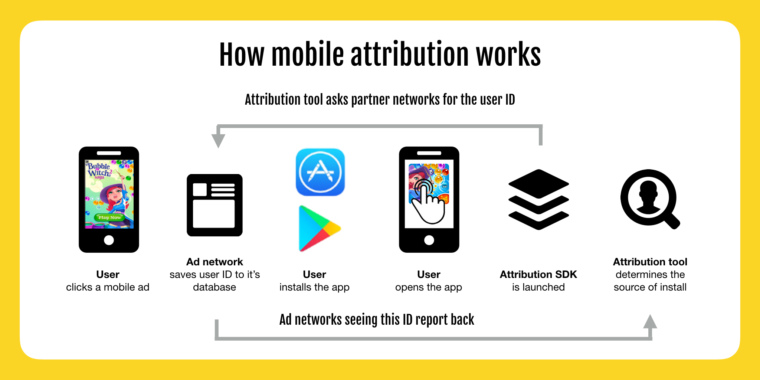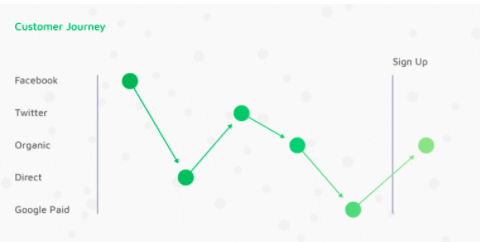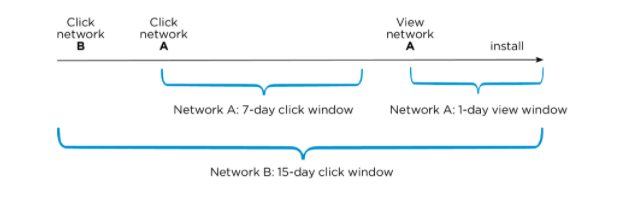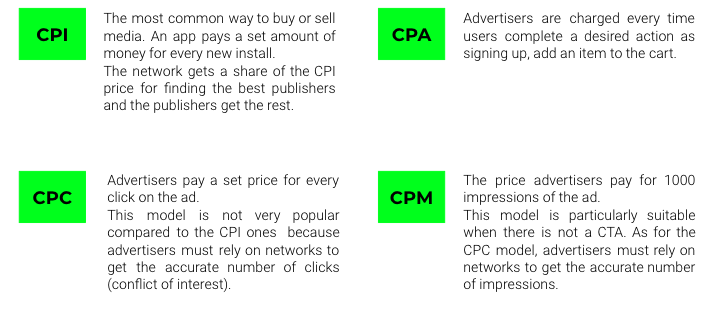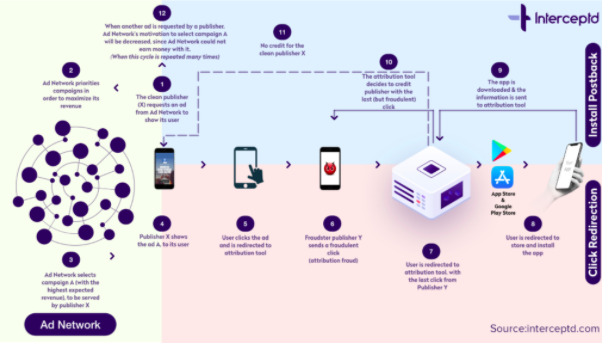An Essential Guide To Mobile Attribution Modeling
It doesn’t matter if you’re a mobile startup or an established publisher with a new app or game, sooner or later you’ll need to measure the effectiveness of your user acquisition campaigns. Attribution is how marketers understand the journey you take to arrive in their app and what you do once you’ve landed there. When done right, there’s a data point for each of the actions a user takes on the journey, from clicking an ad to making a purchase.
What’s mobile attribution?
Attribution modeling is the structure through which advertisers can track and measure the value of different marketing efforts across different channels. It is based on assigning value to a predetermined action taken by users within a given period: this allows advertisers to identify which advertising channels are performing better according to the company’s goals. Attribution modeling is the method advertisers use to determine the value of different channels on their marketing efforts.
How mobile attribution modeling works – the attribution cycle
The principle of mobile attribution isn’t rocket science. Let’s make it simple and explain it simply in the following steps:
1. Suppose you’re using your smartphone to play a game and a video ad pops up. You watch the video and then click on the call to action to install the app.
2. The link redirects you to the app store through the attribution provider: this step takes a fraction of a second but it is essential because this is how the attribution provider receives the first data relating to the engagement with the app.
3. Once the user has clicked on the ad, downloaded the app, and opened it for the first time, the attribution provider will receive this piece of information:
- Advertising id: A string of numbers and letters identifying every smartphone or tablet in the world. es. 38400000-8cf0-11bd-b23e-10b96e40000d
- IP address: A numerical label assigned to each device that uses the Internet Protocol to communicate. es. 168.212.226.204
- User-agent: A line of text that identifies a user’s browser and operating system. es. Mozilla/5.0 (Macintosh; Intel Mac OS X x.y; rv:42.0) Gecko/20100101 Firefox/42.0
- Timestamp: The date and time at which an event occurred (the moment a user clicked on the ad).
- First install: The first time users installed and opened the app.
4. After pairing an ID with an ad network, an attribution SDK sends a postback to all linked networks with the information that the user has already installed the app.
What are the five common mobile attribution models?
With multiple touchpoints across the customer journey, there are several different ways an advertiser can attribute users:
1. First-touch attribution: the entire conversion credit goes to the first point of contact a user had with the campaign.
2. Last-touch attribution: the entire conversion credit goes to the final point of contact a user had with the campaign.
3. Multi-touch attribution: this model assigns diverse weights to different traffic sources for an advertising interaction, leading to several channels benefitting from the interaction.
4. View-through attribution: this model credits an install or in-app event to specific impressions, attributing value delivered by campaigns to ads that don’t directly lead to an install, but feature along the conversion path.
5. Linear attribution: this model assigns equal amounts of attribution to each touchpoint.
First and last-touch models are single-source attribution methods, meaning a conversion is attributed to the user’s first or final point of contact. So, if the final touch before the conversion was on a Google ad, Google receives 100% of the credit. In contrast to this methodology, multi-touch attribution aims to acknowledge every touchpoint that influenced a user to install.
Attribution models can contain elements taken from all five of the methods listed above (for example, a multi-touch attribution model might assign greater weight to the final point of contact).
When can the conversion event be claimed? The attribution window
An attribution window is a period during which eligible conversion events can be claimed. The conversion events can be an app install, added to cart, or purchase.
Attribution windows are an essential tool for helping advertisers and publishers to understand when a conversion takes place.
When dealing with attribution windows, attribution providers must allow flexibility for several reasons:
1. Most conversion events, such as an app install, don’t happen immediately after an ad click. Without allowing for potential gaps between viewing an ad, and installing an app, users could be mistaken as organic, instead of being paid for, which would mean that publishers lose money.
2. Each ad platform and network perform differently in terms of the time range needed to result in a conversion event.
3. Having the ability to set attribution windows helps to weed out false “organic conversions”.
The attribution waterfall
Once a user’s action has been confirmed, the attribution provider begins to look at the past ad engagement to make a match. To do so, the commonly used method is the attribution waterfall: it works backward from the most robust info to the least amount necessary to make the match.
1. Device identifier: The device identifier is a unique identifier that is sent by the publisher to the attribution analytics platforms and then matched on the install level. The default attribution window for device identifiers is usually 7 days.
2. Click Fingerprinting: Fingerprinting refers to a set of non-unique device identifiers – IP, a phone model. It works by using publicly available characteristics of a device to create a “fingerprint” of the user. This could include device, location, and other data relevant to advertisers. Since the identifiers are not unique, the accuracy is around 70%.
3. Impression device: If both device identifiers and click fingerprinting are not available, the attribution provider will look for past impression ad engagements that came through with the same advertising ID.
The economics of attribution
When dealing with attribution there are 4 main models through which ads are bought and sold: CPI, CPA, CPC, CPM
Attribution Manipulation
Attribution manipulation is a harmful form of mobile ad fraud where fraudsters steal credit for action by sending fraudulent clicks, that result in assigning credits to the fraudulent source and removing them from an organic or paid source.
Fraudsters usually exploit the last touch (in this case last click) model to manipulate attribution. Attribution Manipulation is most commonly perpetrated via:
- Click spamming – Click spamming (also known as click flooding) is a type of mobile fraud that sends a large number of fraudulent clicks on an ad without the user knowing, in hopes of capturing the last-click prior to an eventual “organic” install.
- Click injection – Click injection is similar in concept to click hijacking, where a legitimate click is replaced by a fraudulent click as the last touch before an install or purchase event.
- SDK Spoofing – Type of bot-based fraud, often executed by malware hidden on another app. Fraudsters create a bot, hidden in an app, that sends simulated ad click, install, and engagement signals to an attribution provider on behalf of another app (the victim). When successful, these bots can trick an advertiser into paying for installs that did not actually occur.
Wrapping up
Mobile attribution is about connecting various dots. The first dot is something people engage with, like an ad, an email, or a post. The second dot is the action people take, like clicking the ad. The action leads people to the app store and to the next dot. They download the app and open it for the first time. Another dot, and so on, dot after dot. Together, the dots connect advertisements to the choices people make. Matching data points – or dots – between an ad and a user’s interaction with it is the central task of mobile attribution. It’s how marketers understand the journey you take to arrive in their app and what you do once you’ve landed there. When attribution is done right, there’s a dot for each of the actions a user takes on the journey from clicking an ad to making a purchase.
Attribution is essential when dealing with app marketing. We support mobile marketers across all the stages of their app lifecycle, improving performances, and maximizing user engagement, making sure to match data points between ads and user’s interactions.


